The Second World War began on September 1, 1939. However, even before the Germans attacked Poland, there was a clash on the Manchurian-Mongolian border that largely determined the outcome of the future global conflict.
The whole story began quite inconspicuously. On May 11, 1939, the Mongolian cavalry regiment crossed the Chalchyn River gol. The goal of this escapade was a fertile, slightly hilly steppe where the descendants of Genghis Khan intended to graze their shaggy horses. There would be nothing extraordinary about it, if not for a "small" detail. The aforementioned watercourse separated the Mongolian People's Republic and the puppet state of Manchukuo, which remained under the protectorate of Japan.
The Mongols cross the river
At least that's what the Japanese thought. The Mongols saw the problem completely differently. According to them, the border ran all twenty kilometers east of the river. Therefore, the riders, as if nothing had happened, galloped towards the large settlement of Nomonhan, which they believe was a border area. The command of the Japanese Kwantung Army immediately responded to such a disrespect.
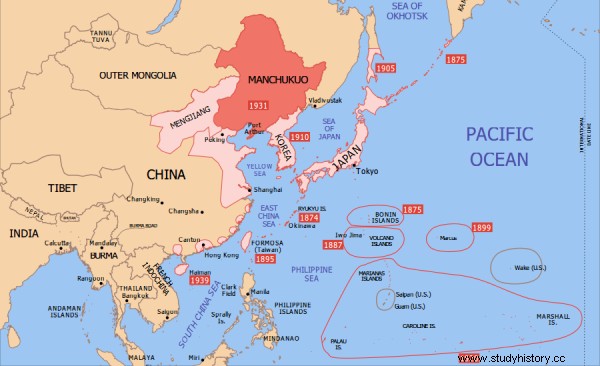
Japanese territorial conquests in East Asia. The Empire of Manchukuo is marked with a dark color (pic. Emok, CC BY-SA 3.0).
The troops stationed in Manchukuo quickly pushed the Mongols behind a Chalchyn goal, but this was a temporary success. Now it was the Mongols who went on to counterattack. In addition, they asked for support from the Soviet Union. For although the Mongolian People's Republic was formally independent, it was in fact completely under the control of the Kremlin. As Antony Beevor writes in his latest book "The Second World War":
The irregular clashes lasted about two weeks. The Red Army drew military reinforcements. On May 28, the Soviet and Mongolian troops smashed a 200-strong unit, destroying several old armored cars.
Then, in mid-June, Soviet air raids on numerous Japanese targets, and ground forces moved to Nomonhan. What initially appeared to be a minor skirmish inexorably turned into a serious conflict.
Conflict enters a new stage
Local Soviet forces were no longer enough. Therefore, the Komdiv Georgy Zhukov - who arrived on June 5 - demanded that his troops be strengthened with units from the Zabaikal Military District. A serious logistical problem arose here. The nearest railway station was located over 650 kilometers from the front.
As a result, the entire burden of transporting soldiers and supplies fell on the shoulders of truck drivers, who took five days to reach their destination. It also had its advantages. The Japanese, knowing about the Soviet troubles, completely ignored the enemy for which they had to pay a high price.
For now, they sent to Nomonhan the 23rd Infantry Division of Lieutenant General Michitarō Komatsubara and elements of the 7th Infantry Division. The command of the Kwantung Army also demanded significant air support from Tokyo.
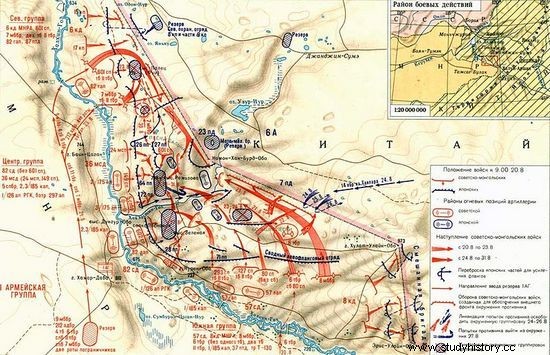
Lord of the battle over Chalchyn goal. The progress of the Soviet troops is marked in red. On the navy blue progress of the Japanese troops (the plan was originally published in the book "Istorija wtoroj mirowoj Warszawy 1939-1945", vol. 2, Moscow 1974)
Concerned about this, the Imperial General Staff, which did not want to escalate the conflict further, decided to appoint a special observer to ease the situation. This news - as the British historian says in his book - prompted the command of the Kwantung Army to speed up operations before the authority restrained his intentions.
In the early morning of June 27, Japanese air force struck Soviet bases in Mongolia. Tokyo was literally in turmoil. The Imperial General Staff immediately banned any further air strikes, but it was too late. On the night of June 30 through July 1, General Komatsubara's troops scored a goal for Chalchyn.
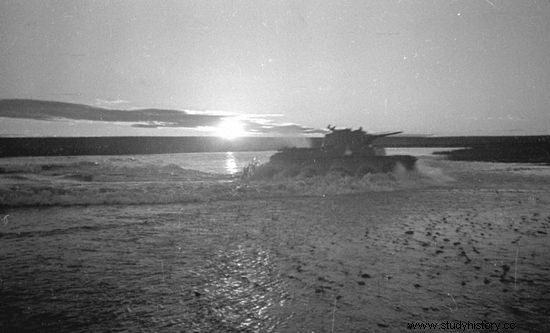
Soviet tank forges Chalchyn a goal. As you can see, it did not constitute any obstacle for the armored forces (photo:Wiktor Antonowicz Tiomin, public domain).
Initially, everything went according to plan and the Japanese occupied the hill overlooking the area. Thus, threatening the Soviet flank. After all, after three days of heavy fighting, Zhukov managed to repel the assault and push the aggressor across the river, and even gain a foothold on its eastern bank.Disgusting defeat of the Japanese
Now the Soviets have started a great mock action - the so-called mask mask. It was supposed to lull the enemy's vigilance. Soldiers were handed out brochures in enormous numbers explaining what the Soviet soldier needed to know about defending, and the sounds of the pile drivers were emitted from the loudspeakers. Meanwhile, Zhukov was already getting ready for a major offensive. Under the cover of night, new units were brought to the front and tanks were concentrated - including the A-32 prototype that was being tested.
The Japanese were also busy and on July 23 they launched another violent attack. This time, however, without much success. Worse, they were also plagued by supply problems, so the third strike had to be postponed.
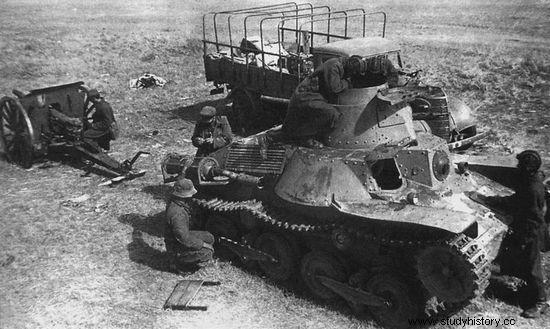
Although the Japanese fought fiercely, they had no chance of winning. Things were definitely not improved by outdated combat equipment. The photo shows the Red Army soldiers seeing the captured Type 95 Ha-Go.
Zhukov eagerly took advantage of the break in the fighting, continuing to increase his strength. Ultimately, he had 58,000 soldiers at his disposal, and about 500 tanks and planes each. The Japanese could oppose him with 65,000 soldiers, over 100 outdated tanks and weak air force. In this situation, Zhukov concluded that he was ready to deliver the decisive blow to the enemy.
The Soviet offensive started on August 20 at 5.45 am. For the next few days there was fierce fighting. The Japanese, although they did not have anti-tank weapons - even their tanks did not have adequate ammunition - put up stiff resistance, inflicting heavy losses on the Red Army. Despite determination, due to the archaic tactics and armament of the Kwantung Army, the fate of the Japanese 6th Army was a doomed.
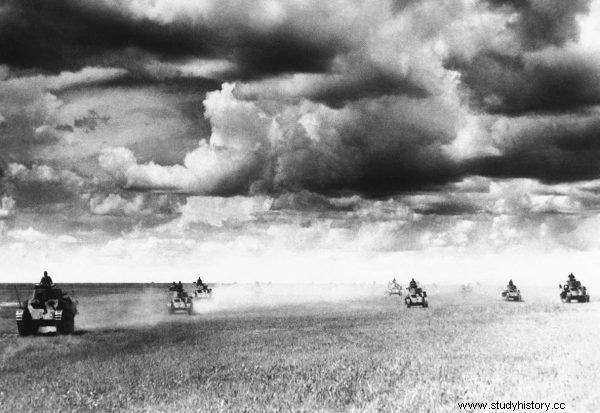
Japanese light tanks on their way to the Chalchyn gol River front (photo:Mainichi Shinbun Sha, public domain).
It was encircled and almost completely destroyed in the massacre that lasted until August 31st. The Japanese claimed that the losses on their side amounted to 8,632 killed and 9,087 wounded. According to the Soviets, they were much higher. Respectively:23,000 killed and 30,000 prisoners. The losses on the Soviet side were more modest. According to Antony Beevor, 7,974 Red Army soldiers were killed and 15,251 injured.
The clashes continued until September 15. It was then that Joseph Stalin - preparing for the invasion of Poland - decided to accept the suspension of arms proposed by the Japanese. It resulted in almost six years of blissful peace on the Mongolian-Manchurian border. It was to play a significant role in the just started World War II.
Far-reaching effects
As Antony Beevor rightly points out in his book: the victory of the Red Army resulted in far-reaching consequences. In the first place, it gave wings to the Chinese, who began to put up harder and harder resistance to the Japanese invaders. In turn, the humiliating defeat made the faction in favor of the war with the Soviet Union suddenly lose its importance in Tokyo. The supporters of the "south expansion" came to the fore.
It was the Battle of Chalchyn Goal that decided that the Japanese attacked the French, Dutch and British colonies in Southeast Asia and Oceania, and even the American navy in the Pacific.
Moreover, remembering a painful lesson, the Japanese did not support Hitler in the winter of 1941, when the Wehrmacht arrived at the gates of Moscow. Thus enabling Stalin to get much needed reinforcements from the Far East. If they had attacked the Soviet Union then, history could have developed quite differently.
